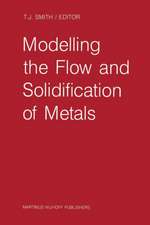High-Pressure Shock Compression of Solids: Shock Wave and High Pressure Phenomena
Editat de J.R. Asay, M. Shahinpooren Limba Engleză Hardback – 24 iun 1993
| Toate formatele și edițiile | Preț | Express |
|---|---|---|
| Paperback (1) | 2093.60 lei 6-8 săpt. | |
| Springer – 8 oct 2012 | 2093.60 lei 6-8 săpt. | |
| Hardback (1) | 2099.77 lei 6-8 săpt. | |
| Springer – 24 iun 1993 | 2099.77 lei 6-8 săpt. |
Din seria Shock Wave and High Pressure Phenomena
- 15%
 Preț: 651.67 lei
Preț: 651.67 lei - 24%
 Preț: 804.03 lei
Preț: 804.03 lei - 18%
 Preț: 1111.97 lei
Preț: 1111.97 lei - 15%
 Preț: 645.28 lei
Preț: 645.28 lei - 18%
 Preț: 948.29 lei
Preț: 948.29 lei - 15%
 Preț: 532.38 lei
Preț: 532.38 lei - 18%
 Preț: 1235.25 lei
Preț: 1235.25 lei - 18%
 Preț: 1132.65 lei
Preț: 1132.65 lei - 18%
 Preț: 1228.96 lei
Preț: 1228.96 lei -
 Preț: 397.01 lei
Preț: 397.01 lei - 18%
 Preț: 949.10 lei
Preț: 949.10 lei - 15%
 Preț: 634.32 lei
Preț: 634.32 lei - 18%
 Preț: 1541.47 lei
Preț: 1541.47 lei - 24%
 Preț: 1040.54 lei
Preț: 1040.54 lei - 15%
 Preț: 642.03 lei
Preț: 642.03 lei - 18%
 Preț: 892.90 lei
Preț: 892.90 lei - 20%
 Preț: 560.55 lei
Preț: 560.55 lei - 18%
 Preț: 1390.73 lei
Preț: 1390.73 lei - 18%
 Preț: 947.50 lei
Preț: 947.50 lei - 18%
 Preț: 957.44 lei
Preț: 957.44 lei - 18%
 Preț: 1126.69 lei
Preț: 1126.69 lei -
 Preț: 384.70 lei
Preț: 384.70 lei - 15%
 Preț: 649.39 lei
Preț: 649.39 lei - 18%
 Preț: 1382.21 lei
Preț: 1382.21 lei -
 Preț: 392.21 lei
Preț: 392.21 lei - 15%
 Preț: 596.36 lei
Preț: 596.36 lei - 18%
 Preț: 1554.72 lei
Preț: 1554.72 lei - 18%
 Preț: 1228.29 lei
Preț: 1228.29 lei - 15%
 Preț: 644.30 lei
Preț: 644.30 lei - 18%
 Preț: 891.80 lei
Preț: 891.80 lei - 18%
 Preț: 951.14 lei
Preț: 951.14 lei - 15%
 Preț: 534.82 lei
Preț: 534.82 lei -
 Preț: 391.79 lei
Preț: 391.79 lei
Preț: 2099.77 lei
Preț vechi: 2560.69 lei
-18% Nou
Puncte Express: 3150
Preț estimativ în valută:
401.79€ • 418.68$ • 332.68£
401.79€ • 418.68$ • 332.68£
Carte tipărită la comandă
Livrare economică 03-17 aprilie
Preluare comenzi: 021 569.72.76
Specificații
ISBN-13: 9780387979649
ISBN-10: 0387979646
Pagini: 393
Ilustrații: XIII, 393 p.
Dimensiuni: 155 x 235 x 24 mm
Greutate: 0.75 kg
Ediția:1993
Editura: Springer
Colecția Springer
Seria Shock Wave and High Pressure Phenomena
Locul publicării:New York, NY, United States
ISBN-10: 0387979646
Pagini: 393
Ilustrații: XIII, 393 p.
Dimensiuni: 155 x 235 x 24 mm
Greutate: 0.75 kg
Ediția:1993
Editura: Springer
Colecția Springer
Seria Shock Wave and High Pressure Phenomena
Locul publicării:New York, NY, United States
Public țintă
ResearchCuprins
1 Introduction to High-Pressure Shock Compression of Solids.- 1.1. Shock-Compression Science.- 1.2. Shock-Compression Events.- 1.3. Responses of Shock-Compressed Solids.- 1.4. Reviews.- 1.5. References.- 2 Basic Principles of Shock Compression.- 2.1. Shock-Wave Concept.- 2.2. Conservation Equations.- 2.3. The “Beads on a Wire” Model.- 2.4. Thermodynamic Effects of Shock Compression and the Hugoniot Curve.- 2.5. Hugoniot Differential Equation.- 2.6. Graphical Representations and the Rayleigh Line.- 2.7. Shock Stability.- 2.8. Expansion Waves.- 2.9. x–t Diagrams.- 2.10. Eulerian and Lagrangian Coordinates.- 2.11. Flow Equations in One Dimension.- 2.12. P–u Diagrams.- 2.13. Surface-Surface Interactions.- 2.14. Wave–Surface Interactions.- 2.15. Wave–Wave Interactions.- 2.16. Entropic Effects.- 2.17. Riemann Integral.- 2.18. Summary.- 2.19. Acknowledgments.- 2.20. Problems.- 2.21. Glossary.- 2.22. References.- 3 Experimental and Diagnostic Techniques.- 3.1. Introduction.- 3.2. Experimental—Production of Planar Shock Compression.- 3.3. Explosives.- 3.4. Guns.- 3.5. Energy Deposition.- 3.6. Prompt Shock-Wave Diagnostics.- 3.7. Arrival-Time Gauges.- 3.8. Particle Velocity Gauges.- 3.9. Stress Gauges.- 3.10. Temperature Gauges.- 3.11. Delayed Shock-Wave Diagnostics.- 3.12. Optical Photography.- 3.13. Flash X-Ray Photography.- 3.14. Post-Mortem Examinations.- 3.15. Summary.- 3.16. Problems.- 3.17. References.- 4 Equation of State.- 4.1. Introduction.- 4.2. Shock-Wave Equations of State.- 4.3. Finite-Strain Equations of State.- 4.4. Pressure-Particle Velocity Curves.- 4.5. Shock-Induced Dynamic Yielding and Phase Transitions.- 4.6. Dynamic Yielding.- 4.7. Equation of State of Porous Materials.- 4.8. Sound Speed Behind Shock Fronts.- 4.9. Shock Temperatures.- 4.10.Acknowledgments.- 4.11. Problems.- 4.12. References.- 5 Inelastic Constitutive Relations.- List of Symbols.- 5.1. Introduction.- 5.2. Small Deformation Theory.- 5.3. Classical Plasticity.- 5.4. Large Deformation Theory.- 5.5. Acknowledgments.- 5.6. References.- 5.7. Appendix: Kinematics.- 6 Influence of Shock-Wave Deformation on the Structure/Property Behavior of Materials.- 6.1. Introduction.- 6.2. Influence of Shock-Wave Propagation on Materials.- 6.3. Shock-Recovery Techniques.- 6.4. Shock Parameter Effects on Material Response.- 6.5. Summary.- 6.6. References.- 7 Micromechanical Considerations in Shock Compression of Solids.- 7.1. Introduction.- 7.2. Microscale, Mesoscale, and Macroscale.- 7.3. Micromechanical Plasticity in Shock Compression.- 7.4. Shock-Amplitude/Pulse-Duration Hardening.- 7.5. Internal Stresses: Micromechanical Effects upon Release from the Shocked State.- 7.6. Heterogeneous Micromechanics.- 7.7. Other Micromechanics.- 7.8. Summary.- 7.9. Problems.- 7.10. References.- 7.11. Appendix: The Shock-Change Equation.- 8 Dynamic Fracture and Fragmentation.- 8.1. Introduction.- 8.2. Spall Strength of Condensed Matter.- 8.3. Fragment Size Predictions in Dynamic Fragmentation.- 8.4. Fragment Size Distributions in Dynamic Fragmentation.- 8.5. Continuum Modeling of Dynamic Fracture and Fragmentation.- 8.6. References.- 9 Large Deformation Wave Codes.- 9.1. Introduction.- 9.2. Governing Equations.- 9.3. Spatial Meshes.- 9.4. Temporal Mesh.- 9.5. Discrete Forms of Governing Equations.- 9.6. Lagrangian Codes.- 9.7. Eulerian Codes.- 9.8. Arbitrary-Lagrangian-Eulerian (ALE) Codes.- 9.9. Example Problems.- 9.10. Summary.- 9.11. References.- 10 Concluding Remarks.- Appendix A.- Appendix B.- Appendix C.- Author Index.


















